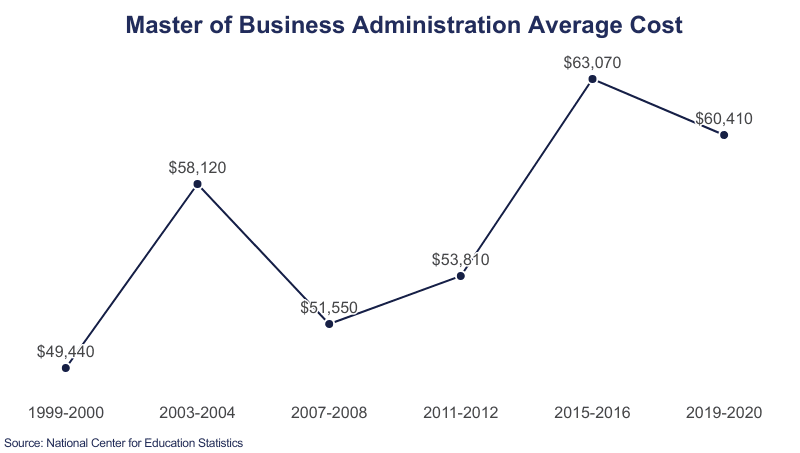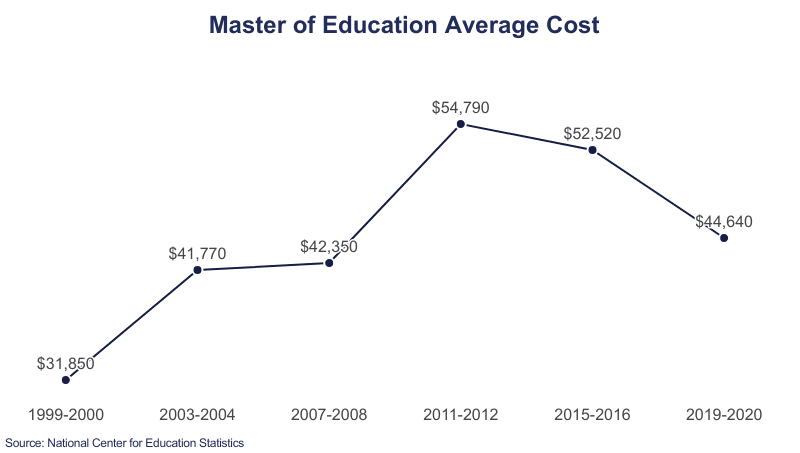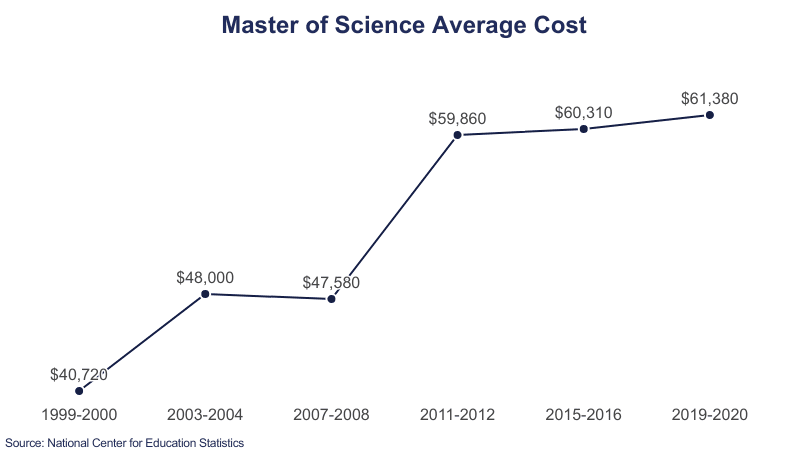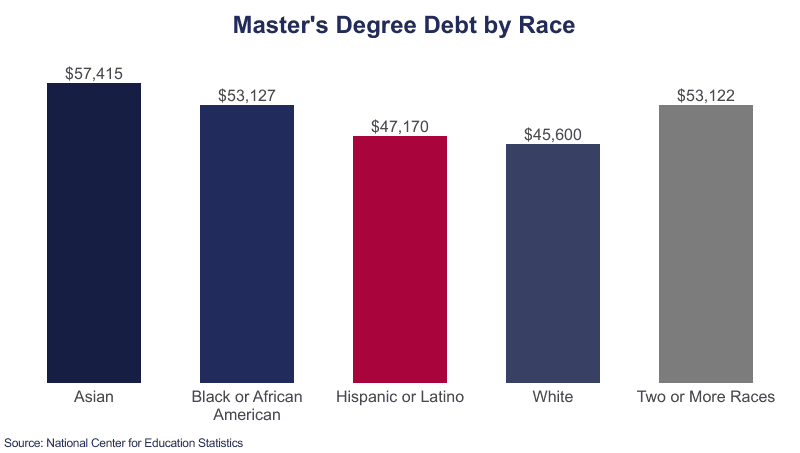Report Highlights. The cost of a Master’s degree typically ranges between $44,640 and $71,140 depending on the school, the major, and the length of the program.
- The average cost of a Master’s degree is $62,820.
- A Master’s degree in Education typically costs $44,640.
- On average, the cost of a Master’s degree in Arts is usually $71,140.
- A Master’s degree in Science typically costs $61,380.
Related reports include Average Cost of College & Tuition | Average Cost of Community College | Average Cost of a Doctorate Degree | Average Cost of Law School | Average Cost of Private School
Master’s Degree Tuition Statistics
Master’s programs generally take up to two (2) years, and students are as likely as undergraduates and doctoral students to receive financial aid, including grant aid, fellowships, and tuition wavers.
- The average cost of a Master’s degree is $51,740 in a public school.
- The average cost of a Master’s degree is $62,550 in a private for-profit school.
- The University of Michigan’s School of Public Policy costs $28,886 for in-state, and $56,658 for out-of-state tuition and fees, per year.
- Meanwhile, the University of Michigan’s School of Business: Master of Accounting program costs $54,310 for in-state, and $59,310 for out-of-state tuition and fees, per year.
- The University of California’s Master of Public Policy program is $29,028 for in-state students and $41,273 for out-of-state students.
- The average Master’s student spends $41,026 on school each school year.
Master of Business Administration
A Master’s degree in Business Administration may be the most popular type of masters degree available, so securing financial aid is a highly competitive process.
- The average cost of a Master’s degree in Business Administration is $60,410.
- The average cost of an MBA degree from 1999 to 2020 was $49,440.
- The cost of an MBA degree from Harvard Business School for a full 2-year program is $161,304.
- Meanwhile, the cost of an MBA degree from Binghamton University is $22,620 for a 2-year program.

Master of Education
Master’s degrees in Education are some of the cheapest Master’s programs available. Teachers who go on to use their degrees in a public and/or disadvantaged district may also be eligible for federal loan forgiveness.
- The average cost of a Master’s degree in Education is $44,640.
- The average cost of a Master’s degree in Education from 1999 to 2020 was $31,850.
- A Master’s degree in Education from Buena Vista University may cost around $6,420.
- A 2-year Master’s degree from Columbia University may cost around $141,260.

Master of Arts
Master of Arts programs may include History, Literature, Languages, and more. Due to the broad range of categories, the amount of financial aid available is program and school-specific.
- The average cost of a Master’s degree in Arts is $71,140.
- The average cost of a Master’s degree in Arts from 1999 to 2020 was $40,550.
- A Master of Arts in History from Florida International University may cost $17,200 for in-state residents, and $36,856 for out-of-state residents.
- A Master’s in Education from Rutgers University may cost $79,478 for out-of-state residents.

Master of Science
A Master of Science degree includes programs such as science, technology, engineering, and medicine (STEM). STEM graduates tend to enter the most in-demand, high-paying jobs that help offset the cost of graduate school.
- The average cost of a Master’s degree in Science is $61,380.
- The average cost of a Master’s degree in Science from 1999 to 2020 was $40,720.
- Texas A&M University estimates the cost of a Master of Science in Engineering from their school is $54,000.
- Among the cheapest programs valued, The University of North Carolina estimates the cost of a Master’s in Engineering Management from their school is $8,665 for residents and $32,947 for non-residents.

Other Master’s Degrees
Programs in this category include Public Administration, Public Health, Social Work, Political Science, and similar fields. Social workers are entitled to some forms of loan forgiveness if they commit to several years of public service. Because of the broad range of categories, the amount of financial aid available is program and school-specific.
- The average cost of a degree in this category is $79,530.
- The average cost of a degree in this category from 1999 to 2020 was $47,470.
- Florida Atlantic University estimates its Master’s in Public Administration (MPA) program may cost $65,300 for Florida residents, and $89,700 for non-residents.
- Evergreen University’s 2-year MPA program costs approximately $9,192 for Washington residents and $19,824 for non-residents.

Cost by Race
The Brookings Institute created a study in 2016 showcasing the debt gap between White graduates and Black graduates pursuing their Master’s degrees. The American Council on Education also created a study in 2020 to study the student debt gap between racial groups. In general, Black Americans were the most likely to borrow and have loans. Asians as a whole had the largest amount of cumulative debt.
- Black graduate school students are roughly 47.8% more likely to acquire graduate school debt.
- From 2004 to 2012 Black enrollment in for-profit colleges increased by nearly 350%.
- Asian students are the most likely group to borrow from private student loan programs or use their savings.
- 42.5% of Asians surveyed took out a loan.
- 77.5% of Black or African Americans surveyed took out a loan.
- 74.7% of Hispanics or Latinos surveyed borrowed money to pay for school.
- 54.9% of White students surveyed borrowed money to pay for school.
- 62.7% of students who originate from two or more races surveyed borrowed money to pay for school.

Additional Costs
Graduates with Master’s degrees had higher average debt in other categories besides student loans.
- People with a Master’s degree held on average $46,798 in student loan debt.
- People with a Master’s degree had on average 26% more credit card debt than the national public’s average.
- People with a Master’s degree had on average 11% less retail card debt than the national public.
- Master’s degree holders carry on average 23% more student loan debt than bachelor’s degree holders.
- Master’s degree holders carry on average 4.7% more auto loan debt than the national public average.
- Graduates with a Master’s degree on average held 44% more personal loan debt than the general public’s average.
- Graduates with a Master’s degree on average held a 37% higher mortgage than the general public’s average.
- Master degree holders carry on average 61% more debt when compared to the general public’s averages.
| Type of Debt | Average with Master’s Degree | National Average |
|---|---|---|
| Credit Card | $8,115 | $6,445 |
| Retail Card | $1,076 | $1,205 |
| Student Loans | $46,798 | $34,906 |
| Auto Loans | $20,012 | $19,117 |
| Personal Loans | $23,443 | $16,249 |
| Mortgages | $275,713 | $201,002 |
Sources
- National Center for Education Statistics (NCES), Digest of Education Statistics
- Experian, The Cost of Education: How Graduate Degrees Affect Debt and Credit
- Brookings Institution, Black-white disparity in student loan debt more than triples after graduation
- Sallie Mae, How America Pays for Graduate School
- American Council on Education, Debt: Master’s Degree Recipient
- Harvard Business School, Annual Cost of Attendance – MBA
- Binghamton University, Costs and Funding
- Buena Vista University, Graduate Tuition and Fees
- Columbia University, Cost of Attendance
- Florida International University, Graduate Tuition & Fees
- Rutgers, 2024-2025 Tuition & Fees By Semester Graduate Schools
- Texas A&M University, Tuition and Fees
- Charlotte School of Professional Studies, Engineering Management
- Florida Atlantic University, Cost of Attendance
- Evergreen State College, Costs and Financial Aid
- Bureau of Labor and Statistics, Should I get a masters degree?
- US Department of Education, 2019–20 National Postsecondary Student Aid Study
- University of Michigan Public Policy Graduate Program, Ford School
- University of Michigan Ross School of Business
- University of California, Irvine: Master of Public Policy